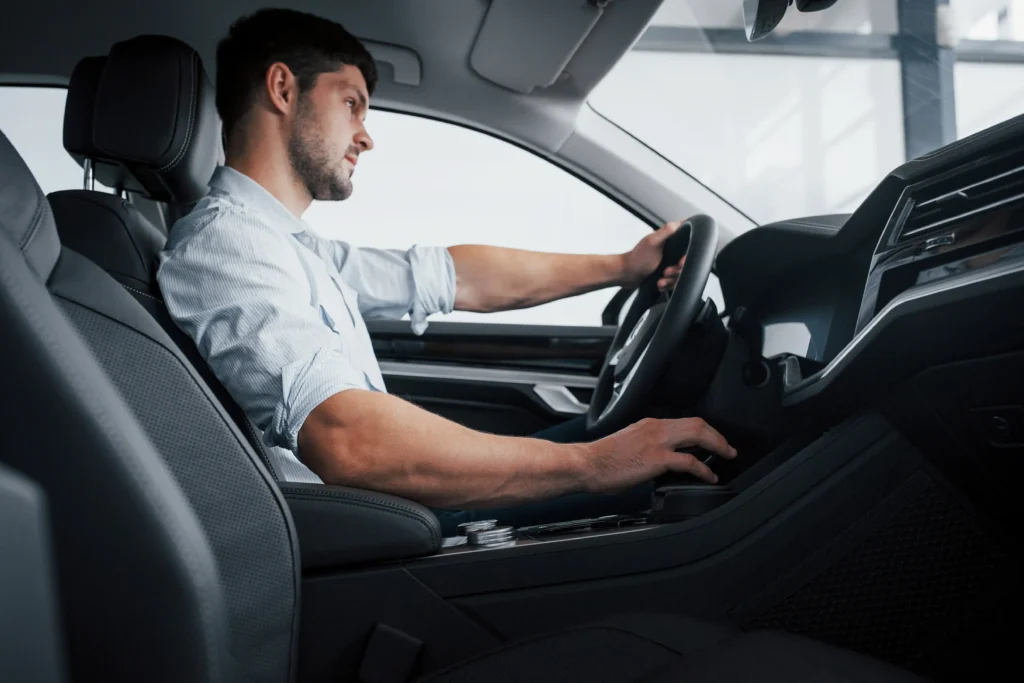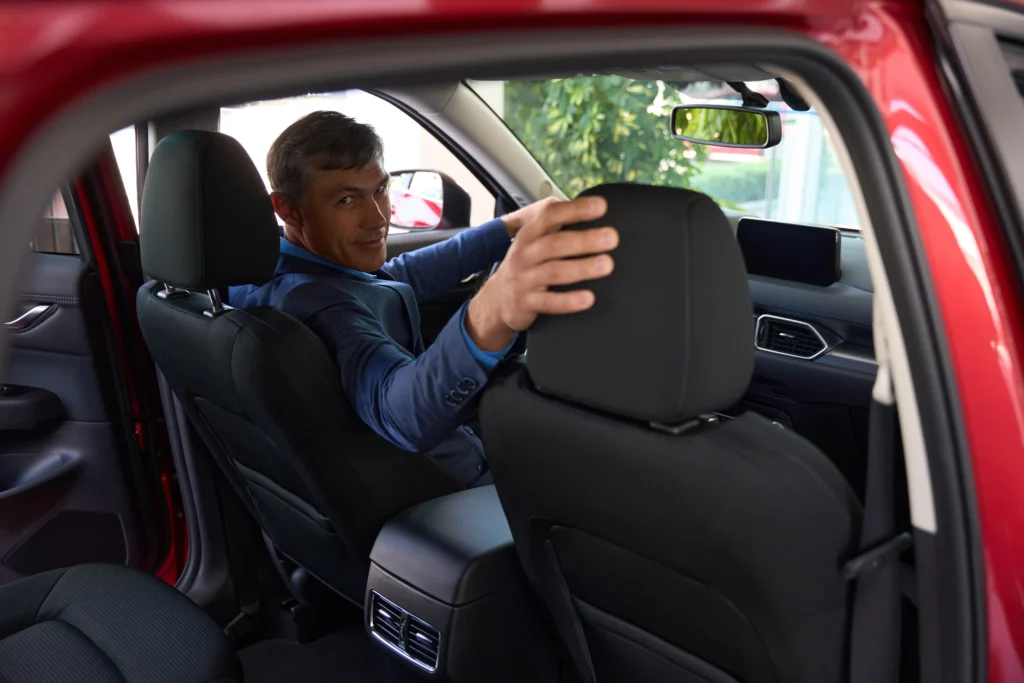
Table of Contents
ToggleBack pain from driving refers to discomfort or stiffness in the back caused or aggravated by long periods behind the wheel. Sitting in a car for extended hours can strain the muscles and ligaments of the back, especially if your posture isn’t optimal or your seat isn’t properly adjusted.
This condition is especially common among those who drive for work, such as truckers or delivery drivers, but it can also affect weekend travelers and daily commuters. Understanding why driving leads to back pain and learning how to manage it is the key to a pain-free experience.

As a spine surgeon with over 25 years of experience, I often see patients who don’t realize how much driving contributes to their back pain. The root cause lies in the combination of static posture, road vibrations, and repetitive movements.
When you sit for long periods, the muscles supporting your spine weaken, and the discs between your vertebrae experience continuous pressure. If you’re slouching, leaning forward, or sitting unevenly, you’re adding extra strain on your lower back.
The vibrations from the road—especially in vehicles with poor shock absorption—compound the issue. These vibrations travel through your body, creating microtraumas in the spine over time.
Additionally, the stop-start nature of traffic means your body is constantly compensating for speed changes, which can fatigue the muscles around your hips and back. Understanding these dynamics can help you address the problem proactively.
Prevention begins with making your car an ergonomic environment. Start by adjusting your seat.
It’s crucial to ensure that your knees are slightly higher than your hips and that your back rests firmly against the seat. Tilting the seat back slightly—to about 100-110 degrees—helps maintain a natural curve in your spine.
If your car doesn’t have built-in lumbar support, you can use a cushion or roll up a towel and place it behind your lower back for added comfort. Your steering wheel position also matters.
Pull the wheel close enough that you don’t need to overextend your arms, which can strain your shoulders and upper back. Adjust your mirrors so you can see clearly without twisting or craning your neck.
Wearing comfortable shoes is another often-overlooked factor. High heels or overly rigid footwear can affect your driving posture, leading to misalignment in your spine.
Taking regular breaks is equally essential. For every two hours of driving, take a 10-15 minute break to stretch and walk around.
This movement helps improve blood circulation and prevents muscle stiffness. If you’re prone to back pain, consider stopping more frequently to do stretches like lunges or standing twists.
These small adjustments can make a significant difference.
When I counsel patients, I often recommend a mix of stretching and strengthening exercises to alleviate back pain. One of my go-to suggestions is the cat-cow stretch, which helps improve spinal flexibility and release tension. Read more here.
Simply kneel on all fours, alternate between arching and rounding your back, and hold each position for a few seconds. It’s easy to perform even in a small space, like a rest area.
Planks are another excellent exercise to strengthen your core muscles, which play a critical role in supporting your back. Start by holding a forearm plank for 20-30 seconds and gradually increase the duration as your strength improves.
If you’ve been sitting for hours, lunges and squats can help reengage your glutes and hips, countering the effects of prolonged sitting. Twists are great for loosening up the spine.
From a seated position, twist your torso to one side, holding the back of the seat for support. Repeat on the other side to evenly stretch your lower back.
These simple movements can be lifesavers during long road trips. Read more here.

Investing in the right tools can greatly reduce the impact of driving on your back. Lumbar cushions are a popular option, designed to support the natural curve of your spine.
Similarly, coccyx cushions can alleviate pressure on your tailbone. Heated seat covers not only keep you warm but also help relax tense muscles, making them an excellent option for colder climates.
Footrests can also be helpful, especially for shorter drivers. Placing your feet on a firm surface ensures proper leg alignment and reduces the strain transferred to your lower back.
If you’re driving long distances, topical pain-relief creams or patches can provide temporary relief. Look for products containing menthol or capsaicin for a warming effect that eases muscle tension.
For those with vehicles equipped with advanced features, take advantage of adjustable lumbar support and seat heaters. These built-in options can significantly improve your driving experience.
If your car lacks these features, aftermarket accessories can often provide similar benefits.
If your back pain persists despite making adjustments and trying exercises, it’s time to consult a medical professional. Chronic pain lasting more than a week, especially if it radiates down your legs or causes numbness, could indicate underlying issues like sciatica or a herniated disc.
As a spine surgeon, I’ve seen many cases where early intervention prevented more severe complications.
It’s also important to pay attention to warning signs like difficulty walking, loss of bladder or bowel control, or unexplained weight loss.
These symptoms could signify more serious conditions that require immediate attention. Don’t hesitate to reach out to a specialist—the sooner you address the issue, the better your chances of recovery.
When you’re already on the road and pain strikes, quick fixes can provide temporary relief. One simple trick is to adjust your position every 15-20 minutes.
Even minor movements, like shifting your weight or pumping your ankles, can prevent stiffness. Applying a heat or cold pack during breaks is another effective method.
Heat relaxes tight muscles, while cold reduces inflammation. Using cruise control, when safe, allows you to place both feet flat on the floor.
This helps distribute your weight evenly and reduces pressure on your back. Massage tools, such as portable seat massagers, can also be lifesavers for long trips.
These small adjustments can make your journey much more manageable.

Not all cars are created equal when it comes to back health. Compact cars with limited legroom may force you into an awkward posture, while vehicles with poor suspension can amplify road vibrations.
As someone who drives often for work, I’ve found that mid-sized sedans with ergonomic seats offer the best balance of comfort and support. When choosing a vehicle, consider the adjustability of the seats and steering wheel.
Some models also come with features like memory foam cushions or built-in lumbar support, which can significantly improve your driving experience. If you’re planning a long trip, test your car’s comfort in advance to ensure it meets your needs.
Your driving habits play a crucial role in maintaining spinal health. Avoid slouching or leaning forward, as this puts unnecessary strain on your lower back.
Instead, sit back against the seat and keep your shoulders relaxed. Smooth acceleration and braking reduce the impact on your spine, making your ride more comfortable.
Planning your route in advance can help minimize stress and avoid overly bumpy roads. Sharing driving duties with a passenger can also prevent fatigue, allowing you to take regular breaks.
Staying hydrated is another simple yet effective strategy. Dehydration can lead to muscle cramps, so always keep a water bottle handy.
The good news is that with proper care and lifestyle adjustments, most cases of back pain from driving can be managed effectively. Physical therapy is often the first line of treatment, focusing on strengthening the muscles that support your spine.
Regular exercise, including yoga and swimming, can improve flexibility and reduce pain over time. For severe cases, advanced treatments like nerve blocks or minimally invasive surgery may be necessary.
At Long Island Neuroscience Specialists, we’ve successfully treated countless patients with chronic back pain, helping them regain mobility and improve their quality of life. If you’re struggling with persistent pain, don’t hesitate to reach out for professional guidance.
Back pain from driving doesn’t have to be a constant struggle. By understanding its causes and implementing practical solutions, you can make your driving experience much more comfortable.
From adjusting your seat and using lumbar support to incorporating regular breaks and exercises, these strategies can alleviate pain and prevent future issues. If you need further assistance, our team at Long Island Neuroscience Specialists is here to help.
With over 25 years of expertise in spine care, we’re dedicated to improving your health and well-being. Contact us today to schedule a consultation.
GET IN TOUCH +
285 Sills Road
Building 5-6, Suite E
East Patchogue, NY 11772
(631) 475-5511
184 N. Belle Mead Road
East Setauket, NY 11733
(631) 675-6226
GET IN TOUCH +
285 Sills Road
Building 5-6, Suite E
East Patchogue, NY 11772
(631) 475-5511
184 N. Belle Mead Road
East Setauket, NY 11733
(631) 675-6226
SUBSCRIBE TO OUR NEWSLETTER +
Send us a Google review. Click this link and let us know how we did!
Review us on Yelp too.